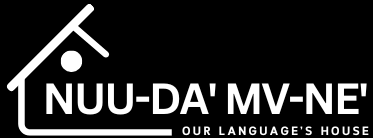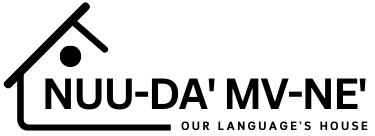History
Nuu-wee-ya’, “our language,” or “our words,” is a term that describes the many dialects of southwest Oregon Dene.
History
About Nuu-wee-ya'
Nuu-wee-ya’ is a Dene language historically spoken in many villages along the southern Oregon and northern California coast, as well as in the Rogue Valley. Since our creation, Nuu-wee-ya'-speaking people have shared a way of life and collective identity across our diverse village territories.
Our homeland extends up the watersheds of rivers, creeks, and coastal lakes, including the upper Coquille River, Floras Creek, Floras Lake, Sixes River, Elk River, Euchre Creek, Rogue River, Illinois River, Galice Creek, Applegate River, Pistol River, Chetco River, Smith River, Lake Earl and Wilson Creek.
In the old times, groups of villages each had their own way of speaking, their own variety. Some of the most well known village groups and varieties include Mish-'ii-xut-me' (Upper Coquille), Sv-k'wee-che' (Sixes), Yuu-k'wi (Euchre), Duu-tuu-dvn (Tututni), Shish-da'-k'wvt-sta (Chasta Costa), Tal-dash (Galice), Daa-kuu-be' (Applegate), Ch'vt-le'sr-chvn-dvn (Pistol River), Chit-xu (Chetco), Xaa-wan'-k'wvt (Smith River area), 'Ee-chuu-let (Lake Earl), and Taa-'at-dvn (Crescent City area).
These varieties can be grouped into dialects based on regular differences in phoneme inventory (the list of sounds that are put together to make words), how verbs are conjugated, and unique vocabulary. There are three dialects of Nuu-wee-ya', called Dv-nee Wee-ya' (Northern), Dee-ni' Wee-ya' (Southern), and Tv-de Wee-ya' (Eastern).
To illustrate the differences, let's look at some examples of sound and vocabulary differences across dialects.
Southern dialect speakers never use the sound tl', and instead use the sound t'. So while someone from the north would say tl'et for night, someone from the south would say t'et for night.
Sometimes the dialects have different words for the same thing. Tolowa speakers call cougar ch'ulh-ts'as-ne (in reference to how it whips its tail), while northern speakers call cougar dii-chu, and eastern speakers say dii~-chu.
Nuu-wee-ya'-speaking elders stated that all the dialects are one language, and that we could all understand each other despite the differences in the way we talked. By learning and teaching each other about all Nuu-wee-ya' dialects, we can carry on our elders' teachings. This will help us to remain strong as a people, and to build a healthy speech community.
Struggle and Revival of Nuu-wee-ya' Speech Community
In the mid-19th century, our homelands were violently settled and eventually forcibly controlled by the United States. Nuu-wee-ya’-speaking people endured a series of hardships and injustices, including genocidal violence, dispossession, outlawing of our way of life, and forced removals to several distinct reservation communities. By the 1940s, there were very few first language Nuu-wee-ya' speakers, and even fewer young people speaking the language.
The last generation of first language speakers of Nuu-wee-ya' passed away in the late 20th century. Today, there are heritage speakers of all dialects of Nuu-wee-ya'. These are people who grew up hearing and speaking the language, but have varying degrees of fluency as adults. One important exception is Tolowa speaker Loren Me’-lash-ne Bommelyn. Loren has spoken Dee-ni' Wee-ya' since childhood, intensively apprenticing with elder speakers. Since then, he has worked closely with elders to document Tolowa, create a dictionary of Tolowa and teach the language.
Across several tribal communities, learners and speakers Nuu-wee-ya' are participating in revitalization efforts. These include language nests, tribal language programming, second language offerings at local schools, grassroots speaking groups, online classes, and other independent work by community members.
Click below to find out more about how Nuu-da' Mv-ne' is working on Nuu-wee-ya' revitalization today.
A LIVING HISTORY
TIMELINE
Through oral histories, community memory, and research, we honor the past and look to the future.
nuu-SRXII-XE, XUU-SRXII-XE HII-CHU XUU-SRXII-XE HII-CHU xaa-ma yaa-'il-sri
FOR OUR CHILDREN, THEIR CHILDREN AND THEIR CHILDREN WE ARE DOING THIS

